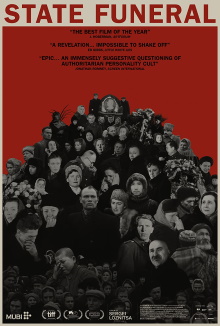This film was compiled from old Soviet footage of the funeral of Joseph Stalin in 1953 by Sergey Loznitsa, a Ukrainian director of Belarusian origin and predates the ongoing invasion. With no added commentary except for an afterword, its surreal quality naturally lends it added resonance this year as it makes for a powerful indictment of the cult of personality built around the supreme leader of the USSR. At a little over two hours long, it’s a bit of a chore to get through as it consists only of the expected pageantry and ceremonies of a huge funeral repeated again and again. Yet I would argue that it’s worth it for the look into the USSR of the period and what such a national cult is like from the inside.
There is no discussion here of who Stalin was or the history of the USSR or Russia. The film immediately opens with shots of Stalin’s corpse being embalmed and made up for public display. News of the death then spreads across the whole of the USSR and its satellite states. We see crowds gather to hear the announcements and queue for newspapers. Delegations of foreign dignitaries then arrive and are welcomed. Next come the wreaths brought to honor the deceased leader and endless throngs of people filing by to look at the corpse lying in state. Finally comes the parade beginning with the other top leaders of the Soviet Union acting as pallbearers to load the coffin onto a carriage and then proceeding at a glacial pace through the city. The important men, and it is only men on the parapet above everyone else, give speeches and then the funeral, which I believe takes place over the course of three days, is over. An afterword then gives some numbers of the people killed during Stalin’s rule and explains how only three years after this excessive display, the Communist Party would condemn the cult of personality around Stalin.
This is undeniably very boring and I would be lying if I said I didn’t find myself glancing at the clock to see how much longer this would take. Yet I would argue that the length of this documentary is finely judged and just right. These ceremonies are meant to proceed at a stately pace and the length captures a little bit of the drudgery of waiting in line for countless hours as so many of the people seen here must have done. With nothing else to do, you find yourself focusing on the smallest details such their manner of dress to determine how prosperous they were at the time and whether or not their grief seems authentic. Personally I feel that while many no doubt participated in these events only out of obligation, many were genuinely distressed. As one of the announcements put it, they have been taught Stalin’s name since they were children and now suddenly he is gone and they would be right to be fearful of what the future holds in store for them. Among the innumerable visitors are a small group of Orthodox priests and their presence to me serves to highlight the complete absence of conventional religion during these ceremonies. That’s only to be expected from Communists of course but in its place they have simply elevated Stalin into a god. The many announcements even state how Stalin has stopped drawing breath and will never rise again, yet he is immortal and will never die. It’s a fascinating phenomenon to witness.
While there are the usual empty platitudes and tiresome exhortations to the workers to redouble their efforts to advance the cause of Communism among the many speeches, I found those of the USSR’s top leaders to be very practical. They emphasize the orderly succession of power and warn enemies against taking advantage of any perceived vacuum of power. They also reaffirm the USSR’s unwavering commitment to Communism. Yet we know that in reality there was a bitter power struggle behind the scenes and as the afterword notes the whole Soviet apparatus did a 180° turn only three years later, making a mockery of this ostentatious display of collective devotion and even deification. This was why this footage shot of the funeral was never used and sat unseen in the archives until Loznitsa dug it up. Even if many Soviet citizens were earnest in their grief, this film shows that this gigantic and expensive event was organized for cynical propaganda purposes and the leaders certainly did not mean what they said in these speeches.
This film regains resonance in our time as Vladimir Putin is actively reviving the old cult of Stalin, claiming that the original move to vilify him was a revisionist take on history that eventually led to the dissolution of the USSR. It’s easy to see why dictators who would equate the entirety of the state with their own person would find such cults of personality, turning themselves into an object of worship to amass absolute power. That’s why it’s important for the rest of us to always remember that everyone, no matter their level of ability or contribution to society, is in the end still just an ordinary human being.
